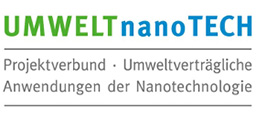UMWELTnanoTECH
ENVIRONMENTALLY COMPATIBLE APPLICATIONS OF NANOTECHNOLOGY

10 Optimisation of the analytics of nanostructured layers
Field of work:
ThermoelectricityIn order to achieve the prospective reduction of greenhouse gas emissions, it is necessary to increase the use of regenerative energy sources and to use waste heat more effectively. Thermoelectric generators are especially suited for energy conversion because waste heat can be converted into electric energy. Suitable material systems for thermoelectric generators should exhibit a thermal conductivity as low as possible and a high electric conductivity. With nanostructuring it is possible to some extent to modify electric and thermal properties independently. The decisive factor for the systematic optimisation of thermogenerators is a precise knowledge of the thermal and electric conductivity of thin and nanostructured layers.
The goal of this project is to provide a combination package of analysis processes which are primarily based on scanning probe microscopy methods to support the development process of material systems for the use in thermoelectric generators.
For this purpose, high resolution analysis processes are to be developed at the Deggendorf Institute of Technology to perform characterisation and error analysis of thermogenerators. Most importantly, this involves the optimisation of scanning probe microscopy methods in order to determine thermal and electric properties of materials and thin layers. Numeric simulations based on finite element methods support the development of measurement methods. In addition to the spatially resolved determination of material parameters, a measurement setup was established to determine the macroscopic thermal conductivity of thin layers. Previously, this method could only be used to measure layers with a thickness of more than 300 nm. With the modifications to the measurement setup developed as part of the project, layers with thicknesses of 50 nm or less can now be studied. To do so, the existing substrate must be modified by depositing a 10 nm thin insulation layer (SiO2). The project partners deliver material systems which are deposited on this layer. Thus, the heat conductivity of these materials can be determined.



